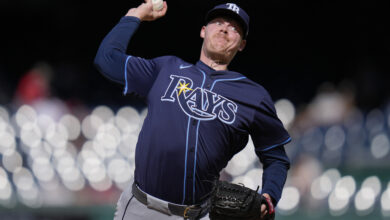
After Passing Important Milestone, Jon Lester Looks to Settle In
Much like last season, Jon Lester had struggled with hard contact this season. In 2018, he allowed the second-highest hard contact of his career (31.9%), a more than 3% increase from a year prior. A year later, Lester is rewriting his career mark altogether, giving up 39.5% hard contact thus far. Opposing batters are squaring Lester up like never before, already accumulating the same number of barrels (28) he allowed in all of 2017 and generating an average exit velocity of 88.5 mph.
Fortunately for Lester, the season is far from over. As the calendar currently reads the middle of July, he has roughly 12-14 more starts to improve upon his 9.1% barrel rate and lofty hard contact figure mentioned above. Setting those things aside, Lester is actually enjoying a rather solid season. His 3.74 ERA ranks among the top 20 qualified National League starters while his 22.8% strikeout rate is more than 3% better than last season.
Even with a 4.24 FIP, largely due to his unsightly contact figures, Lester has remained at the forefront of a Cubs pitching staff that has been solid this season. As was the case in 2018, he is vastly out-pitching his peripheral numbers. Much of that can be attributed to keeping the ball on the ground (43.9% groundball rate) and not allowing free base runners (5.3% walk rate).
That performance, combined with his aforementioned uptick in strikeout rate, has permitted the lefty to limit the damage from the 17 home runs he’s given up while allowing him to average better than 5.5 innings per outing. And there’s reason to believe his comfort level can yet improve. In his last start, 6.2 innings of eight-hit, three-run ball against the Pirates, Lester crossed an important seasonal threshold that he uses to to judge his performance.
During an interview with Chicago Tribune writer Mark Gonzales in June of last season, Lester revealed he uses the 100-inning milepost to really get settled into a season.
“I still feel that mark is an important mark,” Lester said. “I still feel that’s an important number, and I feel that’s where you kind of get going downhill.”
For any pitcher, especially one who missed time with an injury early in the season, getting the proper feel for their pitches can take time. As Lester ages, the command of his cutter (and other offerings) becomes paramount to his success as the margin for error decreases. Though he’s just now at 101 innings and will likely fall short of 200 innings for the second straight year, it looks like the southpaw is rounding into form for a second half push.
Over his last two outings, Lester has logged a 2.77 ERA, dropping his hard contact to a more manageable 33.3%. He has combated his 4.52 FIP by inducing groundballs 45.5% of the time and holding opponents to a .304 OBP by maintaining a healthy 5.3% walk rate. As is the case with most 35-year-old pitchers, fans must live with the bad to get the good. Last season proved Lester can pitch effectively with lackluster peripheral numbers and diminishing fastball velocity.
Despite his velocity dipping again in 2019, Lester owns double-digit whiff rates on all five of his primary offerings, including a 39.4% mark with his curveball. That would be the fifth-best mark of his career and opposing hitters are averaging just .224 with a .245 slugging percentage on the pitch.
With the experience of last season under his belt and his important mid-season checkpoint behind him, Lester seems like a prime candidate for prolonged success in the second half. For his career, Lester has allowed a .687 OPS to opponents down the stretch, besting his career first half figure of .699.
While not a meaningful difference, Lester’s winning percentage increases 46 points post-All-Star break, showing the seasoned veteran knows how to pitch when the lights are bright. Locked in a tight division race, the Cubs need all of that they can get in 2019.

